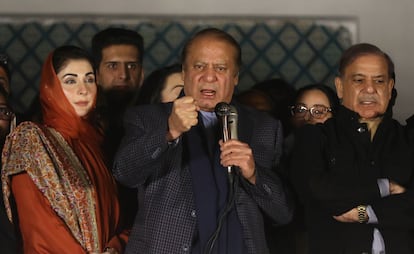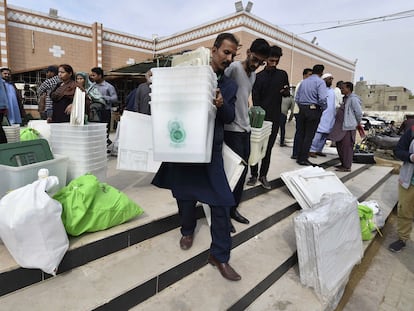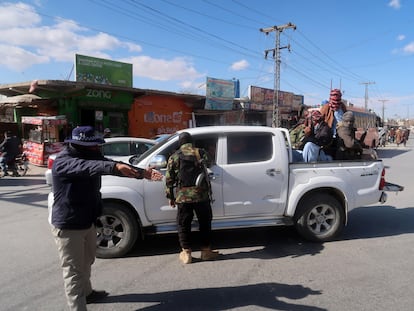Pakistan, a country divided between two political dynasties
Shehbaz Sharif, brother of former prime minister Nawaz Sharif, has been chosen to lead the government with the support of the Bhutto family’s party, which has produced two other heads of government and whose leader will run for the presidency


Politics in the turbulent nation of Pakistan remains a matter of family clans. Thursday’s general elections were marred by violence and accusations of fraud. Following the voting, the two main parties in the National Assembly that emerged victorious from the polls, the symbols of two political dynasties that have monopolized a large part of the power in recent decades, agreed this week to join forces and vote to install 72-year-old Shehbaz Sharif as prime minister, with the support of other minority parties. If successful, the pact would effectively rule out the party of imprisoned former prime minister, Imran Khan, whose independent candidates headed the poll and are the leading force in parliament, though they do not command a sufficient majority to form a government on their own. This Thursday, Khan’s party also nominated its secretary general, Omar Ayub, as its candidate for prime minister, although he appears to be lacking the required support.
The likely next prime minister, Shehbaz Sharif of the PML-N, had previously served briefly as head of government between 2022 and 2023, following the no-confidence motion that dislodged Khan from power. In those months, he had to grapple with a similar coalition of parties. Shehbaz is the younger brother of the also former prime minister, Nawaz Sharif, who has been at the head of the executive on as many as three occasions. Nawaz was the man who was actually running as the leader of PML-N after returning from a four-year self-imposed exile and having the convictions against him quashed. However, ultimately it was his brother who was nominated for investiture, after striking a deal with the other dominant political dynasty in the world’s fifth most populous nation (235.8 million inhabitants in 2022) — namely, the Bhutto dynasty.
The third party in the Assembly, the Pakistan People’s Party (PPP), is led by Bilawal Bhutto-Zardari, son of Benazir Bhutto, the first female head of government in a Muslim country, who was assassinated in 2007, and grandson of former prime minister, Zulfiqar Ali Bhutto, who was ousted and executed by the military in 1979. Bilawal confirmed on Monday that he would support the PML-N candidacy, albeit without joining its government. In terms of the distribution of powers, Asif Ali Zardari, father of Bilawal Bhutto, widower of the assassinated Benazir Bhutto and co-chairman of the PPP, will be proposed for the post of president of the country, a position he previously held between 2008 and 2013.
The vote is expected to take place in the coming weeks in a parliament in which Imran Khan’s independent candidates secured 93 seats, as compared to 75 for Sharif’s party, and 54 for Bhutto. In the elections, the candidates were competing for 264 seats out of the 336 total in the assembly. The rest are seats reserved for women and minorities, which are distributed according to the division of power, although independent members are not included in this allocation. The prime minister must be sworn in with a simple majority of 169 votes.
“We have decided to form a coalition government [to] lead the country out of the [current] crisis,” Bhutto-Zardari said during an appearance in Islamabad in which both parties were present, along with other minority political forces that intend to lend their support to the investiture. “The critical phase of the elections is over, and a new parliament will now be formed. We need to settle our differences in order to carry our nation forward and rebuild our economy,” pointed out Shehbaz Sharif, who ensured that the parties supporting him hold a two-thirds parliamentary majority. Zardari even sought the backing of the Pakistan Movement for Justice (PTI), the party of the imprisoned Khan, as part of a reconciliation process. “Everyone has to be on board with the economic agenda in the broader interest of the nation,” said the politician, as reported by the Pakistani media outlet Geo News.
Crisis in a nuclear country
The atomic nation is struggling to cope with a complex situation. On the one hand, there are the shockwaves of a growing spiral of violence linked to insurgent militias in the areas bordering Afghanistan. On the other hand, it is immersed in a post-pandemic economic crisis, with a rampant inflation rate of around 30%, and the country is confronting a debt black hole that will require the negotiation of a new bailout with the International Monetary Fund. Last summer, Islamabad — with Shehbaz as prime minister at the time — agreed a package of $3 billion with the multilateral organization in exchange for a stabilization program, which expires in March. The renegotiation will constitute one of the central tasks of the new government.
Nawaz Sharif governed in three intervals between 1990 and 2017 and his successive rises and falls encapsulate the country’s recent history. In the 1990s, he alternated in power with the assassinated Benazir Bhutto, but was driven out of the country after clashing with General Pervez Musharraf, who he had himself appointed as head of the military. Musharraf staged a coup d’état and seized power to become president in 2001. Sharif returned years later, and served as prime minister again in 2013, but in 2017 he resigned amidst the revelations of the so-called Panama Papers, which linked him and his family (including his daughter Maryam) to companies in tax havens. He was convicted of corruption and fled again into self-imposed exile.
During his absence in 2018, Imran Khan’s PTI prevailed in the elections after managing to arouse the hopes of a good part of the electorate, especially the youth and the educated sectors of Pakistani society. However, once at the helm, 71-year-old Khan, a former national cricket superstar, clashed with the powerful military, whose influence continues to be decisive. He was ousted from power in a parliamentary no-confidence vote in 2022, and replaced by Shehbaz Sharif, which would pave the way for the return of his self-exiled brother, Nawaz Sharif, last October. Shortly after his arrival, he appealed his convictions, which were overturned in December, thanks to the change in the political climate. Shortly afterwards, he presented his candidacy to the National Assembly for last Thursday’s elections.
Since election night, Khan’s PTI party has seen its allegations of fraud multiply in an election to which it arrived in disarray. Its leader was in prison, having several convictions totaling dozens of years, and its candidates were running as independent runners, after the Election Commission banned the party from using its emblematic symbol, a cricket bat, in the elections. The party has decried a strategy of political persecution. Shortly before the elections, the U.N. High Commissioner for Human Rights expressed its “concern” at “the pattern of harassment, arrests and prolonged detention of PTI leaders and its supporters,” in addition to the numerous court cases against Khan.
Sign up for our weekly newsletter to get more English-language news coverage from EL PAÍS USA Edition
Tu suscripción se está usando en otro dispositivo
¿Quieres añadir otro usuario a tu suscripción?
Si continúas leyendo en este dispositivo, no se podrá leer en el otro.
FlechaTu suscripción se está usando en otro dispositivo y solo puedes acceder a EL PAÍS desde un dispositivo a la vez.
Si quieres compartir tu cuenta, cambia tu suscripción a la modalidad Premium, así podrás añadir otro usuario. Cada uno accederá con su propia cuenta de email, lo que os permitirá personalizar vuestra experiencia en EL PAÍS.
¿Tienes una suscripción de empresa? Accede aquí para contratar más cuentas.
En el caso de no saber quién está usando tu cuenta, te recomendamos cambiar tu contraseña aquí.
Si decides continuar compartiendo tu cuenta, este mensaje se mostrará en tu dispositivo y en el de la otra persona que está usando tu cuenta de forma indefinida, afectando a tu experiencia de lectura. Puedes consultar aquí los términos y condiciones de la suscripción digital.
More information
Archived In
Últimas noticias
Welcome to the post-religion era: The idea of Christianity as the absolute truth has become obsolete
‘I thought you would like it’: The risky sexual practice popularized by TV shows and TikTok
The digitalization of tourism: ‘They promise experiences and gave us the worst possible one’
Mexican peso defies uncertainty with forecasts of a new period of stability in 2026
Most viewed
- Sinaloa Cartel war is taking its toll on Los Chapitos
- Reinhard Genzel, Nobel laureate in physics: ‘One-minute videos will never give you the truth’
- Oona Chaplin: ‘I told James Cameron that I was living in a treehouse and starting a permaculture project with a friend’
- Why the price of coffee has skyrocketed: from Brazilian plantations to specialty coffee houses
- Silver prices are going crazy: This is what’s fueling the rally










































